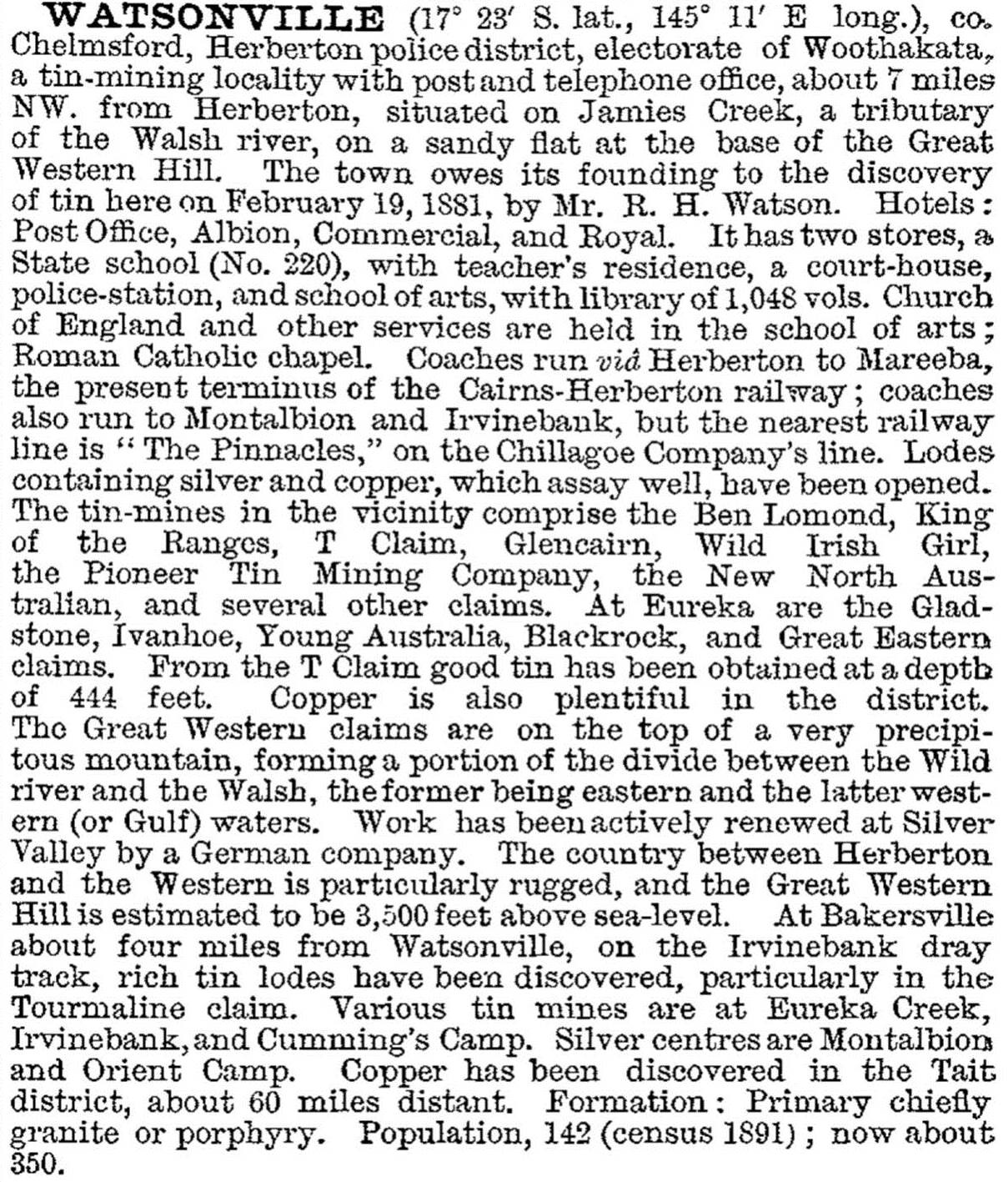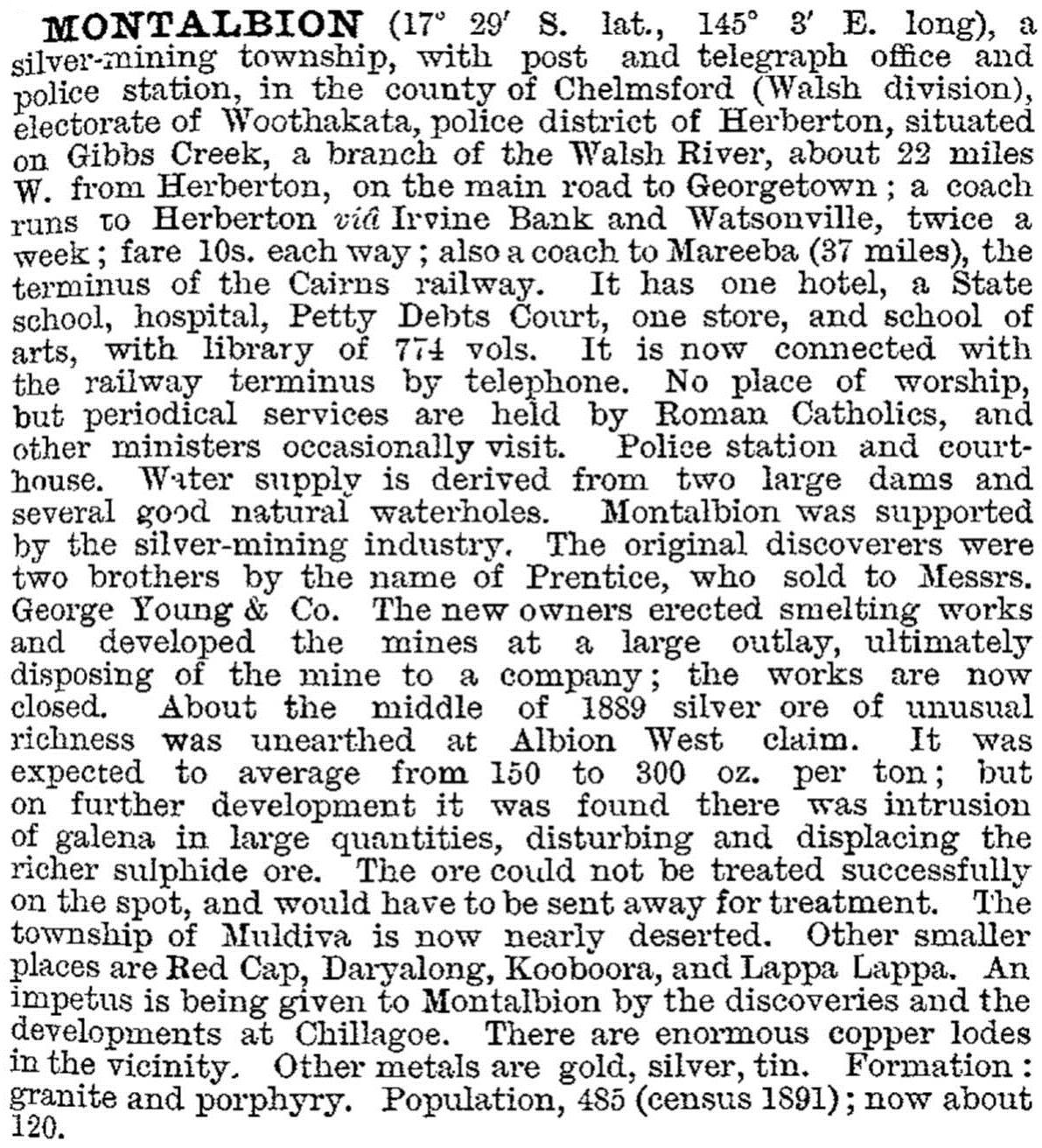The Herberton Minerals Area, generally 20 km west of Herberton, had an active life between 1880 and 1930. Its four main towns were Irvinebank, Montalbion, Stannary Hills and Watsonville. Each of the last three towns at some time probably had a population of 500 people or more.
Watsonville, closest to Herberton, originated with the discovery of the Great Western Tin Lode by Robert Watson in 1880. Western Hill is on a direct line between Herberton and Irvinebank. Within two years the Western mining camp was active, and it was surveyed and named Watsonville in 1882. The town was on a sandy flat at the northern base of Western Hill and was the principle centre for several mining camps around it. The post office directory for 1897 recorded three hotels in Watsonville, along with a store, Catholic and Primitive Methodist churches, a billiard saloon, a school of arts and a private school with an average attendance of 51 pupils. Mining was operated in reliance on John Moffat's Irvinebank interests. He opened a quartz battery at Watsonville in 1911, but it lasted for less than a year. Watsonville was described in the 1903 Australian handbook:

Today Watsonville has numerous mine ruins, a cemetery and a fig tree marking the site of the primary school.
In 1883 discoveries occurred north and west of Irvinebank. To the north tin lodes were found on the headwaters of the Eureka Creek, and silver and tin lodes were found along Gibbs Creek to the west.
The Eureka Creek site developed as the town of Stannery Hills (so named c1900 from the Latin 'Stannum', meaning tin). Reputedly Stannery Hills had a peak population of 800 people of whom half were employed in mining and woodcutting. The Post Office directory of 1906 recorded five hotels, seven stores (including one of the Jack and Newell chain), a post office and a station on the Irvinebank tramway. By 1924 numerous miners and two hotels continued, but ten years later only a few miners and the Federal Hotel were left.
The Gibbs Creek discoverers, the Prentice brothers, sold their interest to George Young and John Moffat of Irvinebank. The new owners erected smelters at the mine site, named Montalbion. Within a year of the smelters being fired (1886) an English company, Mount Albion Silver Mining and Smelting, was brought in, and the discovery of the Albion West silver ore lode (1889) added to the profits. Montalbion was described in the 1896 issue of the Australian Handbook as having four hotels, three stores, a hospital, a court, a school of arts, but no church. There were two dams on Gibbs Creek. The 1891 census recorded 485 people, but by 1900 the estimated population was 120. In that year Moffat dismantled the smelter, transferring it to Mount Garnet, and three years later the hospital and school buildings were transferred to Irvinebank. Montalbion had a life of less than 20 years. It's decline was noted in the 1903 Australian handbook:

Moffatt centralised his activities in Irvinebank, which was connected to the Mareeba-Chillagoe rail line by a tramway, built in stages during 1902-07. The tramway ran via Stannery Hills, missing Montalbion and Watsonville. Its most important function was bringing in fuel for smelting; passengers travelled at their own risk, with spectacular gorges, horseshoe bends and tea and scones at Stannery Hills. The tramway ran until 1936, giving Stannery Hills a longer life than the other two towns.
Census populations were:
| Census Area | Census Date | Population |
|---|---|---|
| Montalbion | 1891 | 485 |
| 1901 | 176 | |
| Watsonville | 1891 | 142 |
| 1901 | 234 |
K.H. Kennedy, ed, Readings in North Queensland mining history, Vol 1, Townsville, History Department, James Cook University of North Queensland, 1980

